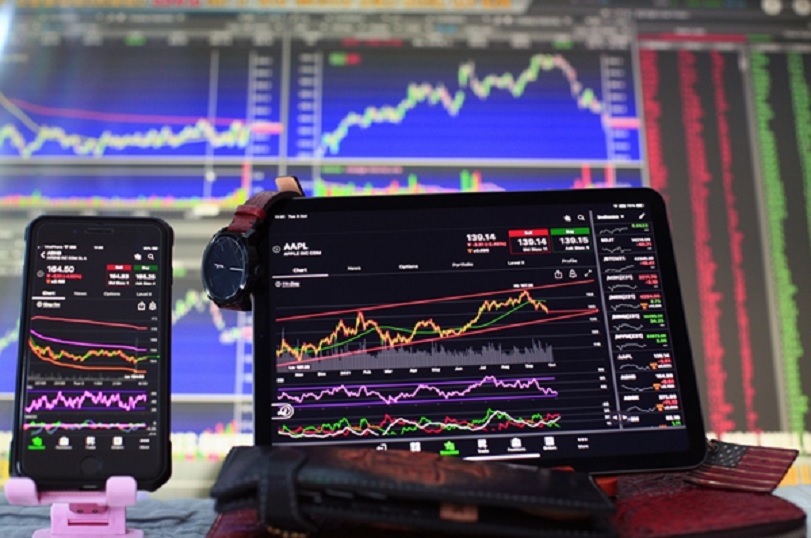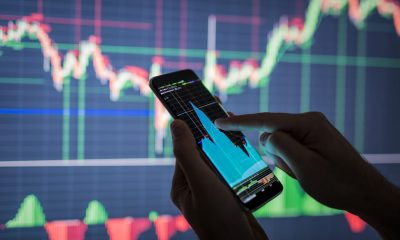Economy
Unlocking Profits: Harnessing the Power of Trading Apps

In the fast-evolving world of finance, trading apps have become a crucial tool for investors seeking to unlock profits and optimize their trading strategies. These digital platforms, such as forex trading apps and stock trading apps, offer a plethora of features designed to enhance trading efficiency and accessibility. In this article, we explore how these applications are revolutionizing the trading landscape, allowing traders of all levels to harness their power effectively.
The Rise of Trading Apps
Trading apps have transformed the way individuals engage with financial markets. No longer confined to the realm of professional brokers and financial analysts, these apps provide real-time market data, advanced analytical tools, and direct trading capabilities right at the user’s fingertips. Whether it’s for trading stocks, forex, or other financial instruments, these apps democratize access to global markets, making it possible for anyone with an internet connection to participate in trading. This accessibility has opened up opportunities for a new demographic of traders, breaking down the traditional barriers that once made the financial markets seem inaccessible and complex. Now, individuals can manage their investments, monitor market trends, and make informed decisions with ease and efficiency. The intuitive design of these apps caters to both novice and experienced traders, offering customized interfaces that can be tailored to each user’s trading style and preferences. This shift not only empowers more people to enter the markets but also enriches the trading landscape with greater diversity in participation.
Key Features of Trading Apps
One of the standout features of modern trading apps is their ability to provide comprehensive market analysis tools. These include interactive charts, live price feeds, historical data analysis, and predictive modeling tools. For instance, a forex trading app not only allows users to trade currencies but also offers them tools to analyze forex market trends, set stop-loss orders, and track performance in real-time.
Another crucial feature is the seamless integration of educational resources. Many apps come equipped with tutorials, webinars, and articles that help users understand the nuances of market movements and trading strategies. This educational aspect is vital for new traders, empowering them with knowledge to make informed decisions.
Enhancing Trading Efficiency
The convenience of trading apps significantly enhances trading efficiency. With the ability to execute trades anytime and from anywhere, these apps ensure that users never miss out on a potentially lucrative trade. This is particularly important in highly volatile markets, such as forex, where currency values can fluctuate dramatically within minutes.
Recent market activity illustrates the volatility that traders must navigate. For example, the NASD OTC’s recent 2.36% decline on return from a 3-day break underscores the dynamic nature of financial markets. Traders equipped with real-time data and analytical tools from trading apps were better positioned to respond to these changes effectively.
Reducing Costs and Increasing Accessibility
Trading apps also play a pivotal role in reducing the costs associated with trading. By eliminating the need for physical brokers and reducing transaction fees, these apps make trading more cost-effective. Furthermore, the user-friendly design of these apps lowers the entry barrier for amateur traders, allowing them a greater chance to participate in trading activities traditionally dominated by more experienced professionals.
Security Aspects
Security remains a top priority for trading app developers. With significant sums of money being transacted daily, these apps incorporate advanced security measures like two-factor authentication, encryption, and continuous security audits to protect user data and funds. The confidence that these security measures inspire is crucial for maintaining user trust and facilitating smooth trading experiences. Additionally, many apps are now implementing biometric security features such as fingerprint scanning and facial recognition to provide an extra layer of security. These technologies ensure that only the authorized user can access their account, significantly reducing the risk of unauthorized access. Moreover, developers regularly update their software to patch any vulnerabilities and to defend against new types of cyber threats. These proactive security practices are essential not only for safeguarding assets but also for ensuring that the trading platform remains reliable and trustworthy, thus enhancing user engagement and retention.
The Future of Trading Apps
As technology advances, trading apps continue to evolve. The integration of artificial intelligence and machine learning into these apps is set to redefine trading strategies. These technologies can provide personalized trading insights, automate trading actions, and analyze vast amounts of data to predict market trends more accurately.
Conclusion
Trading apps are more than just tools; they are gateways to financial empowerment. By offering real-time access to global markets, educational resources, and essential trading tools, they provide an unprecedented level of support to traders. Whether you are using a forex trading app to trade currencies or monitoring stock fluctuations after significant market events, these apps are integral to modern trading strategies. As the digital landscape expands, the potential for these tools to enhance trading outcomes continues to grow. With the right approach and continuous learning, traders can effectively harness the power of trading apps to unlock significant profits and achieve trading success.
Economy
LCCI Raises Eyebrow Over N15.52trn Debt Servicing Plan in 2026 Budget

By Adedapo Adesanya
The Lagos Chamber of Commerce and Industry (LCCI) has noted that the N15.52 trillion allocation to debt servicing in the 2026 budget remains a significant fiscal burden.
LCCI Director-General, Mrs Chinyere Almona, said this on Tuesday in Lagos via a statement in reaction to the nation’s 2026 budget of N58.18 trillion, hinging the success of the 2026 budget on execution discipline, capital efficiency, and sustained support for productive sectors.
She noted that the budget was a timely shift from macroeconomic stabilisation to growth acceleration, reflecting growing confidence in the economy.
She lauded its emphasis on production-oriented spending, with capital expenditure of N26.08 trillion, representing 45 per cent of total outlays, and significantly outweighing non-debt recurrent expenditure of N15.25 trillion.
According to Mrs Almona, this composition supports infrastructure development, industrial expansion, and productivity growth.
However, she explained that the N15.52 trillion allocation to debt servicing underscored the need for stricter borrowing discipline, enhanced revenue efficiency, and expanded public-private partnerships to safeguard investments that promote growth.
She added that a further review of the 2026 budget revealed relatively optimistic macroeconomic assumptions that may pose fiscal risks.
“The oil price benchmark of $64.85 per barrel, although lower than the $75.00 benchmark in the 2025 budget, appears optimistic when compared with the 2025 average price of about $69.60 per barrel and current prices around $60 per barrel.
“This raises downside risks to oil revenue, especially since 35.6 per cent of the total projected revenue is expected to come from oil receipts.
“Similarly, the oil production benchmark of 1.84 million barrels per day is significantly higher than the current level of approximately 1.49 million barrels per day.
“Achieving this may be challenging without substantial improvements in security, infrastructure integrity, and sector investment,” she said.
Mrs Almona said the exchange rate assumption of N1,512 to the Dollar, compared with N1,500 in the 2025 budget and about N1,446 per Dollar at the end of November, suggests expectations of a mild depreciation.
She said while this may support Naira-denominated revenue, it also increases the cost of imports, debt servicing, and inflation management, with broader macroeconomic implications.
The LCCI DG added that the inflation projection of 16.5 per cent in 2026, up from 15.8 per cent in the 2025 budget and a current rate of about 14.45 per cent, appeared optimistic, particularly in a pre-election year.
She also expressed concern about Nigeria’s historically weak budget implementation capacity, likely to be further strained by the combined operation of multiple budget cycles within a single year.
Looking ahead, Mrs Almona identified agriculture and agro-processing, manufacturing, infrastructure, energy, and human capital development as key drivers of growth in 2026.
She said that unlocking these sectors would require decisive execution—scaling irrigation and agro-value chains, reducing power and logistics costs for manufacturers, and aligning education and skills development with private-sector needs.
The LCCI head stressed the need to resolve issues surrounding the Naira for crude, increase the supply of oil to local refineries to boost local refining capacity and conserve the substantial foreign exchange used for fuel imports.
“Overall, the 2026 Budget presents a credible opportunity for Nigeria to transition from recovery to expansion.
“Its success will depend less on the size of allocations and more on execution discipline, capital efficiency, and sustained support for productive sectors.
Economy
Customs Street Chalks up 0.12% on Santa Claus Rally

By Dipo Olowookere
The Nigerian Exchange (NGX) Limited witnessed Santa Claus rally on Wednesday after it closed higher by 0.12 per cent.
Strong demand for Nigerian stocks lifted the All-Share Index (ASI) by 185.70 points during the pre-Christmas trading session to 153,539.83 points from 153,354.13 points.
In the same vein, the market capitalisation expanded at midweek by N118 billion to N97.890 trillion from the preceding day’s N97.772 trillion.
Investor sentiment on Customs Street remained bullish after closing with 36 appreciating equities and 22 depreciating equities, indicating a positive market breadth index.
Guinness Nigeria chalked up 9.98 per cent to trade at N318.60, Austin Laz improved by 9.97 per cent to N3.20, International Breweries expanded by 9.85 per cent to N14.50, Transcorp Hotels rose by 9.83 per cent to N170.90, and Aluminium Extrusion grew by 9.73 per cent to N16.35.
On the flip side, Legend Internet lost 9.26 per cent to close at N4.90, AXA Mansard shrank by 7.14 per cent to N13.00, Jaiz Bank declined by 5.45 per cent to N4.51, MTN Nigeria weakened by 5.21 per cent to N504.00, and NEM Insurance crashed by 4.74 per cent to N24.10.
Yesterday, a total of 1.8 billion shares valued at N30.1 billion exchanged hands in 19,372 deals versus the 677.4 billion shares worth N20.8 billion traded in 27,589 deals in the previous session, implying a slump in the number of deals by 29.78 per cent, and a surge in the trading volume and value by 165.72 per cent and 44.71 per cent apiece.
Abbey Mortgage Bank was the most active equity for the day after it sold 1.1 billion units worth N7.1 billion, Sterling Holdings traded 127.1 million units valued at N895.9 million, Custodian Investment exchanged 115.0 million units for N4.5 billion, First Holdco transacted 40.9 million units valued at N2.2 billion, and Access Holdings traded 38.2 million units worth N783.3 million.
Economy
Yuletide: Rite Foods Reiterates Commitment to Quality, Innovation

By Adedapo Adesanya
Nigerian food and beverage company, Rite Foods Limited, has extended warm Yuletide greetings to Nigerians as families and communities worldwide come together to celebrate the Christmas season and usher in a new year filled with hope and renewed possibilities.
In a statement, Rite Foods encouraged consumers to savour these special occasions with its wide range of quality brands, including the 13 variants of Bigi Carbonated Soft Drinks, premium Bigi Table Water, Sosa Fruit Drink in its refreshing flavours, the Fearless Energy Drink, and its tasty sausage rolls — all produced in a world-class facility with modern technology and global best practices.
Speaking on the season, the Managing Director of Rite Foods Limited, Mr Seleem Adegunwa, said the company remains deeply committed to enriching the lives of consumers beyond refreshment. According to him, the Yuletide period underscores the values of generosity, unity, and gratitude, which resonate strongly with the company’s philosophy.
“Christmas is a season that reminds us of the importance of giving, togetherness, and gratitude. At Rite Foods, we are thankful for the continued trust of Nigerians in our brands. This season strengthens our resolve to consistently deliver quality products that bring joy to everyday moments while contributing positively to society,” Mr Adegunwa stated.
He noted that the company’s steady progress in brand acceptance, operational excellence, and responsible business practices reflects a culture of continuous improvement, innovation, and responsiveness to consumer needs. These efforts, he said, have further strengthened Rite Foods’ position as a proudly Nigerian brand with growing relevance and impact across the country.
Mr Adegunwa reaffirmed that Rite Foods will continue to invest in research and development, efficient production processes, and initiatives that support communities, while maintaining quality standards across its product portfolio.
“As the year comes to a close, Rite Foods Limited wishes Nigerians a joyful Christmas celebration and a prosperous New Year filled with peace, progress, and shared success.”
-

 Feature/OPED6 years ago
Feature/OPED6 years agoDavos was Different this year
-
Travel/Tourism9 years ago
Lagos Seals Western Lodge Hotel In Ikorodu
-

 Showbiz3 years ago
Showbiz3 years agoEstranged Lover Releases Videos of Empress Njamah Bathing
-

 Banking8 years ago
Banking8 years agoSort Codes of GTBank Branches in Nigeria
-

 Economy3 years ago
Economy3 years agoSubsidy Removal: CNG at N130 Per Litre Cheaper Than Petrol—IPMAN
-

 Banking3 years ago
Banking3 years agoFirst Bank Announces Planned Downtime
-

 Banking3 years ago
Banking3 years agoSort Codes of UBA Branches in Nigeria
-

 Sports3 years ago
Sports3 years agoHighest Paid Nigerian Footballer – How Much Do Nigerian Footballers Earn
















